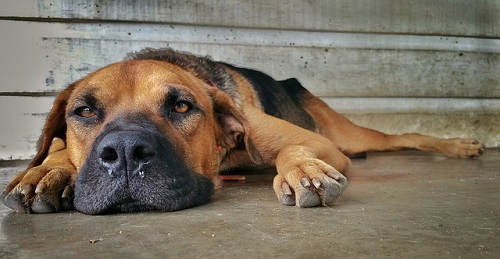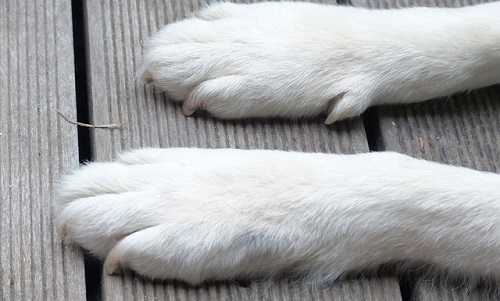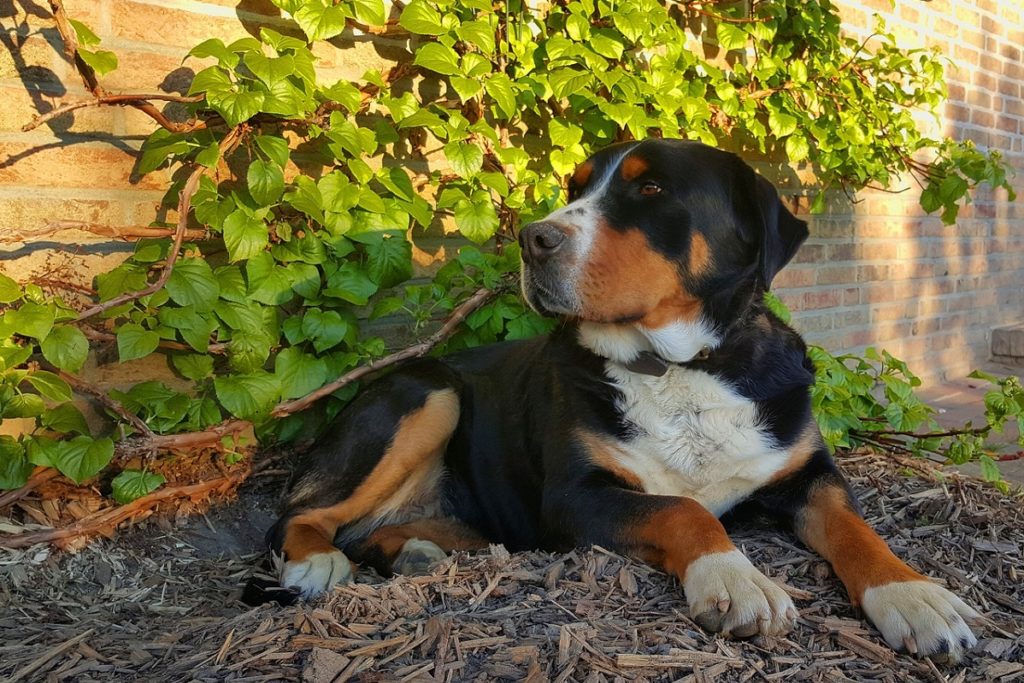Even though a dog’s feet have paw pads, their paws still have to be cared for and protected. The paw pads on a dog are the tough, thick, leathery skin designed to help absorb shock on joints and bones when a dog walks, runs, and stands. The paw pads also help a dog to navigate steep and unsteady terrain and offer some insulation against extremely cold weather conditions.
Despite their tough appearance and many functions, a dog’s paw pads are just as vulnerable to injury as your feet or mine. This means that regular care should be given to them to keep them healthy and injury free.
Make it a routine habit to inspect your dog’s feet whenever they come in from outside and make sure there is no mud, debris, or dirt left behind that can cause cracked dog paws. You should also clean their feet regularly as part of your grooming routine to help keep their paws healthy.
Common Paw Problems
There are a variety of paw problems a dog can suffer from, including burns, blisters to the dog’s footpad, punctures and lacerations, abrasions, pads that are cracked and dry, and even foreign objects lodged between their toes.
When something is wrong with your dog’s paw, they may show symptoms such as limping, lameness, bleeding, favoring the injured foot and keeping it lifted from the ground, and compulsive chewing and licking of the paw. Discoloration of the paw pad can also occur, although if your dog’s paw pads are very dark, it may be difficult to see the discoloration.
Whatever your dog’s symptoms may be, it is important you inspect his feet thoroughly and try to identify the source of the problem. Even though a dog’s paw pads are thick and padded, they are not indestructible, and they can easily become burned and blistered from high heat, frostbitten from extreme cold, or wounded from rough terrain and sharp objects.
For Dog Paw Burns and Blisters
Inspect your dog’s foot and look for loose flaps of skin on the paw pad, or areas where a flap of skin has detached, leaving the area red and inflamed. To treat a blister or burn, use a mild antibacterial soap to wash the paw, and cover it loosely with a self-adhesive bandage while it heals. If you notice a loose flap of skin left on the pad, leave it alone and allow it to come off naturally. If it really bothers you, you can ask the vet to trim it.
For Dog Paw Abrasions and Lacerations
Your dog’s footpads are chock-full of blood vessels, which means that even if they receive a minor cut, it can seem like there is a copious amount of blood. Depending on how deep the puncture or laceration is, the bleeding should stop once you have treated the injury and applied some compression. If the bleeding continues even after cleaning, treating, and compressing the wound, you will need to contact your vet right away.
 If your dog suffers from a small cut or abrasion, you can clean it with a mild antibacterial soap, and then bandage the paw loosely using gauze and paper tape or a self-adhesive bandage. Keep your dog from chewing or licking at the bandage either by muzzling him or using a cone caller.
If your dog suffers from a small cut or abrasion, you can clean it with a mild antibacterial soap, and then bandage the paw loosely using gauze and paper tape or a self-adhesive bandage. Keep your dog from chewing or licking at the bandage either by muzzling him or using a cone caller.
Also, bear in mind that dogs sweat through their feet, so you need to keep any bandages clean and dry to reduce the risk of a canine bacterial infection and speed up the rate of healing. Most cuts if they aren’t too deep should heal within a few days or so.
If you notice that a cut doesn’t seem to be healing, or you aren’t sure if your dog needs additional treatment, see your vet. If your dog has suffered from a laceration that is deep, they may need stitches and possibly a splint. A splint helps to keep a deep laceration from reopening and re-injuring your dog when they put his weight on his foot.
Note that dogs can also pick up foreign objects in between their toes that can cause pain and injury. Most often you will find small pieces of glass, small rocks, burrs, and dried mud. Use tweezers to remove anything that shouldn’t be there, and if needed you can trim fur that is matted using a small pair of scissors.
Always remember that if you aren’t sure where or how an injury originated, or if you aren’t comfy cleaning and treating the wound yourself, you should take your dog to see the vet and let them do it. Additionally, if at any time you notice that your dog’s paws are red and swollen or they don’t seem to be healing properly, also see your vet because there could be an infection present.
For Dog Paw Cracking and Dryness
Dogs can also suffer from paw pads that get cracked and dry. Though a dog’s paws are supposed to be rough to the touch for traction purposes, they should never be dry or cracked. Dogs need the traction to help them turn and stop and sprint quickly, but your dog’s paw pads should feel more like a kitty’s tongue rather than the Sahara Desert.
Unfortunately, when they are cracked and dry, they can collect debris and dirt. This can cause dog paw pad injuries. And, despite all your best efforts, dogs can still suffer from cracked, painful paw pads no matter what you do, which can be highly frustrating.
In many cases, cracked paw pads are a reaction to your dog’s environment. Remember that a dog’s paw pads are a lot like the bottoms of your feet. Any harsh chemicals you might use on your floor can be transferred to your dog’s paw pads and cause dryness and irritation.
Some dogs also like to lick and chew their paws obsessively, for a variety of reasons. Sometimes the dog licks their paws because of an irritation or pain they are attempting to alleviate. Experts theorize that paw licking could be linked to a pH imbalance which can occur when a dog doesn’t get enough meat in their food. You can always test the theory by feeding them more protein!
It’s also thought that cracked paw pads may result from zinc deficiencies, which is why your vet might recommend giving your dog a fish oil supplement to boost their numbers. Senior dogs can get cracked paws too, related to a condition of old age called hyperkeratosis.
Hyperkeratosis is when your dog produces too much keratin and it causes your dog’s paws to begin to crack. For a human analogy, think of corns on the feet of your grandpa, and you might get the picture.
In fact, a dog’s paw pads are a lot like human feet in many ways. Think about how your feet respond when you walk around barefoot a lot. If you walk around on tough or rough ground, the soles and heels of your feet get tougher, dryer, and more callused. Sometimes they might even start to crack too, depending on the kind of care and attention you give them. This is especially true if you aren’t moisturizing your feet on a regular basis.
A dog’s paw pads are very similar, and the texture and roughness of the pad can change with their environments as well as the seasons. Dogs from cold weather areas suffer from cracked paw pads more often because of the salts on the ground, and because the snow will often refreeze between their toes.
Dogs from hot climates can also suffer from cracked paws, especially if they walk on hot asphalt or sand frequently, though it is more common in colder climates.
How to Treat Cracked Dog Paws
If you notice that your dog’s paw pads seem to be cracking, but the cracking looks to be mild, you may not need to do anything, they could heal up on their own. Just make sure your dog isn’t excessively licking them, because their paw pads need to stay clean and dry.
If the cracking worsens, however, or you notice your dog’s paw pads starting to bleed, you will need to take additional steps to treat the problem. Start by cleaning any blood and grime off the paw. Then you can apply a balm or salve to your dog’s paw such as Vaseline or Neosporin.
Once you put Vaseline or Neosporin on your dog’s foot, put a sock over it and use paper tape around the ankle to keep it in place. Check your dog’s paw pads every day, reapply ointment as necessary, and make them take it easy until the pads are completely healed.
There are also paw pad moisturizers specifically designed for dogs with dry, cracked paws. Just avoid using human lotion, because that could cause more harm than good by making your dog’s paw pads too soft. The idea is to keep them moisturized, but still sturdy enough to withstand the demands of their environment.
If canine allergies are playing a role in your dog’s cracked paws, it’s important to see your vet and try to determine the underlying cause of the allergy. If it’s a food allergen, you can try tweaking your dog’s diet to help improve the situation or eliminate certain foods or ingredients to see if that helps.
 Sometimes certain supplements may be useful, especially omega-3 fatty acids. If your dog appears to be allergic to something in the environment, the best recourse is avoidance if at all possible. Unfortunately, dogs will often lick and chew on their paws obsessively in reaction to an allergy, and that only serves to dry the paws out, encourages them to crack, and introduces contaminants and bacteria that can lead to infection. It’s a vicious cycle and it can be extremely frustrating if you are unable to narrow down what your dog may be reacting to.
Sometimes certain supplements may be useful, especially omega-3 fatty acids. If your dog appears to be allergic to something in the environment, the best recourse is avoidance if at all possible. Unfortunately, dogs will often lick and chew on their paws obsessively in reaction to an allergy, and that only serves to dry the paws out, encourages them to crack, and introduces contaminants and bacteria that can lead to infection. It’s a vicious cycle and it can be extremely frustrating if you are unable to narrow down what your dog may be reacting to.
Another problem in treating dogs with cracked paws is the fact that the problem is on their feet. Their feet bear the brunt of their weight, and if their paws are cracked and tender, putting weight on them only makes it worse. So, it’s important that you crate your dog and make them rest for a few days, to give the broken skin a chance to heal properly.
Preventing Cracked Dog Paws
You should only expose your dog to new terrains in small increments of time. If your dog’s feet are not used to hot pavement and sand, or used to frozen ice and snow, or to rocky, uneven ground, then their feet will be tender and vulnerable to injury if you walk them for long periods under such conditions.
If they are tender and vulnerable, their paws may react with cracking. By exposing your dog’s paws to new environments in small increments of time, your dog can gradually toughen the pads of their feet to withstand the new terrain without injury or repercussions.
Another way to help protect your dog’s paw pads is put dog boots on them. There are also special products like foot wax that can help protect them, although they aren’t nearly as effective or reliable. Foot wax can wear off or be misapplied, dog boots cannot.
Avoid using harsh chemicals in your home to clean your floors and choose natural floor cleaners instead. The same goes for your lawn. Avoid harsh chemicals, fertilizers, and garden sprays. Opt for natural solutions, and make sure to wash your dog’s feet whenever they have been outside for any length of time.
Finally, if your dog refuses to leave their paws alone and they are contributing to the problem rather than solving it, you may need to use a cone collar on them temporarily. A cone collar makes it difficult for your dog to reach their feet and discourages excessive licking, giving your dog’s cracked paws some much needed time to heal.




